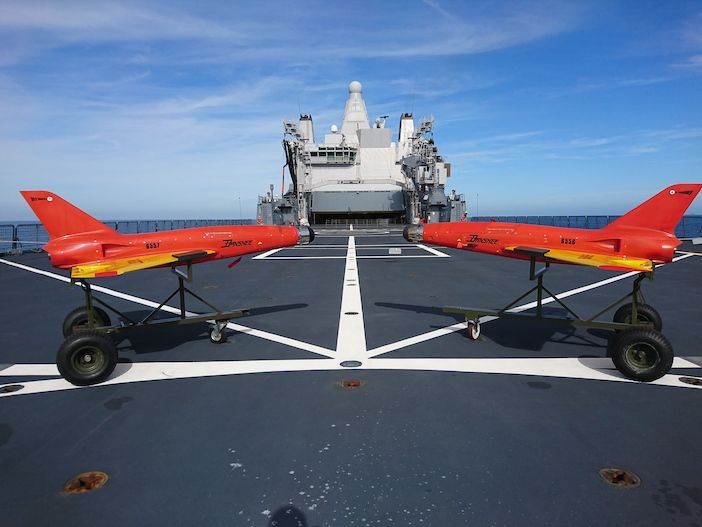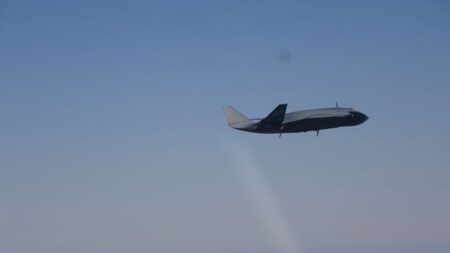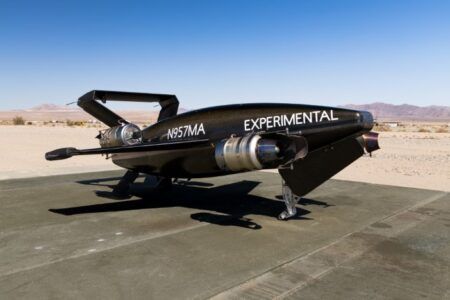Words by Paul Eden
Remotely-controlled aircraft have provided targets for weapons trials since the 1950s. Today’s weapons manufacturers and militaries employ a variety of aerial, land and surface targets in trials.
June 26 1935, a de Havilland DH.82B Queen Bee lifts off at Farnborough, UK in the first demonstration of the type’s remote-control system. Flown via push buttons on a specially designed panel, the aircraft maneuvers around the airfield before returning to land on its wheeled undercarriage.
Designed and built as a practice tool for anti-aircraft gunners, the Queen Bee paved the way for similar conversions of existing, usually surplus military aircraft and the post-war development of more specialized ‘drones’ for military training or trials. Capability, performance and cost, bearing in mind success is most often measured in the craft’s own destruction, have always driven the production of remotely controlled targets. Latterly, as guidance systems moved from air-to-air and surface-to-air missiles into precise air-to-ground munitions, the requirements of aircraft weapons trials and for target drones changed.
Laser and electro-optically guided air-to-ground weapons appeared operationally during the 1960s and had matured by the time of the 1991 Gulf War. Subsequently, a new breed of weapon emerged, capable of engaging maneuvering surface targets moving at speed. Proving such systems has brought dedicated land and surface vehicles into the aerospace testing remit.
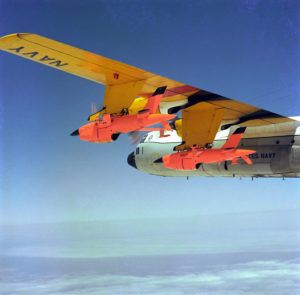
Global requirements
In 2016, Meggitt Aerospace sold its Target Systems business to QinetiQ in a £57.5 million (US$75 million) deal. QinetiQ Target Systems (QTS) offers aerial, land and surface (maritime) targets and has continued to invest in new capabilities and systems. It supplies its products off the shelf or within a bespoke service for individual trials.
Jules Werner, business development manager, QinetiQ Target Systems, says, “Customers come to us with a set of requirements. We work to understand exactly what they’re trying to achieve, then our field services people pack everything together. It’s like a Formula 1 team, with all the equipment and control systems deployed in a series of trucks.
“Typically, we deploy a five- or eight-person team, depending on the requirements and number of targets. We often send teams and equipment to overseas locations and currently operate in more than 40 countries.
“At the end of the trial, we de-rig, load the equipment back in the trucks and ship it back to our facilities. The customer receives a set of results and has the opportunity to witness whatever aspect of the trial they need to see.”
Fundamentally, there is no difference between flying a drone as a target for weapons practice compared to flying for training purposes, but Werner says QTS always listens carefully to its customers’ requirements. “We might do a series of tracking runs if that is what is needed. Sometimes the trial calls for the target’s destruction, sometimes it doesn’t, but we always consider that a target has a working lifetime, is built to a certain cost and isn’t designed to be used for many years,” he says.
Surface Targets
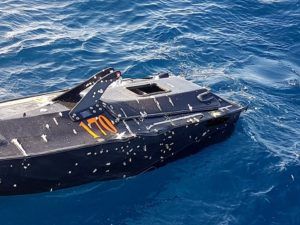
A variety of Unmanned Surface Vehicle-Targets (USV-T) options is available for engagement by naval, vehicle and other military systems, and from the air. And while it is perhaps more relevant to military training exercises, QTS has the ability to operate multiple surface targets – as many as 40 simultaneously.
Surface targets may be engaged from the air, providing a more serious challenge for missiles that are designed to track and destroy fast-moving vehicles. Interestingly, the naval targets are also offered for trials of weapons designed for use against land targets. “We can simulate a fast-moving land target at sea, which may help avoid the complications of carrying out such trials on land,” Werner says.
Like its range of aerial targets, QTS designs and builds its surface targets rather than modifying existing vehicles. Targets are also equipped to employ additional features, such as jamming, augmented radar signature and configurable electromagnetic emissions. “Since we’re simulating a threat, the target also needs to maneuver like the threat system. Operators at the target control station might ,with an aerial target for example, maneuver it in an attempt to defeat the weapons system under test,” Werner says.
“For an aerial target we’ll establish exactly what type of profile the customer wants the target to fly, then one of our pilots will control it, knowing all the time where it is. The process is very similar for a surface target.”
The target operating crew always remains in contact with the customer throughout. This means if a technical issue arises with the target or a test point is missed, arranging a repeat run is relatively simple.
With more complex systems, there is a higher chance of a technical glitch. The test can also be modified while out in the field. Werner says, “For example, when we’re working with a ship, a
sensor might fail and the customer will ask us to change the target’s tracking or behavior. We’re so close to the customer we can adapt the profile even during a firing run.”
Aerial targets
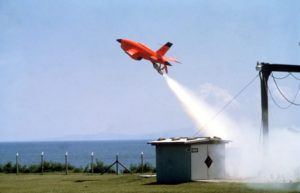
The aerial targets QTS produces may be launched from land or sea, offering considerable flexibility in settling customer requirements. In the case of Rattler, aerial launch is another possibility. Overseas trials occasionally present difficulties in terms of locating and securing suitable operating areas, and the ability to move a trial from one place to another, with viable launch options, is a great facilitator.
Meggitt developed the Banshee target, which QTS continues to offer and develop as its smallest aerial target, or UAV-T. The basic propeller driven model is joined by a selection of jet-powered derivatives, offering higher speeds, but also generating the IR signature associated with a jet. They may be equipped with the company’s Hot Nose system, capable of generating a 360° IR signature. “This year we launched the Banshee Next Generation, a high-performance target, but we also have the Rattler, which is supersonic. We look ahead and speak with our customers to define the threats of the future.
“We’re always conscious of cost. A system costing £3 million [US$4 million] per ‘kill’ would be unaffordable so we look carefully at the prices customers might be willing to pay.”
An increasing challenge
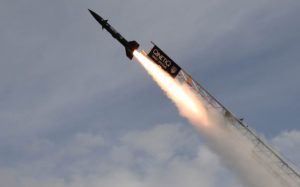
(Photo: QTS)
The requirement for creating technology that will challenge a high-tech weapons system and generate data in the process, combined with the need to create a replaceable, essentially throw-away target, is particularly challenging.
Customers typically use targets to prove manufacturer’s claims for a weapons system and QTS equips them accordingly. Equipment fit, data collection and data transmission will vary depending on range facilities and much of the technology is sensitive.
Werner says, “We put sensors and recording equipment onto targets and customers have their own too, often recording data during flight. They’ll want to know what happened when the weapon hit and what happened beforehand. If it didn’t hit, they’ll want to know why. They’ll also assess how close the weapon came and we can install equipment that will tell them that. Customers look for similar data from surface and land targets too.”
As weapons systems evolve, so do the requirements QTS’s customers place on the targets. Werner says, “We’ve seen fast-moving patrol craft become a threat, for example, and developed Hammerhead to simulate them.
“In the future customers will want faster, more maneuverable targets with low radar cross section, capable of simulating fast-moving missiles that might threaten shipping from land or air.”
In its Rattler ground/air-launched supersonic target QTS has a versatile target capable of exceeding Mach 2.0. Much of its flexibility comes from distinct launch profiles, either from land/ship, or beneath a Banshee Jet 80. In the latter case, the Banshee may assume the role of a missile-firing aircraft, releasing the Rattler at stand-off range against a ship to simulate a supersonic weapon, then turning away. Depending on the scenario, the result could set the defenders the double challenge of defeating the Rattler and preventing the Banshee escaping to return another day.
It’s a complex target system that QTS invested in after talking closely with its customers. That policy echoes through the company’s offering, which Werner says also benefits from the resources of the wider QinetiQ organization. The result is not only an essential trials and training tool kit, but also a fully deployable trials
support organization.
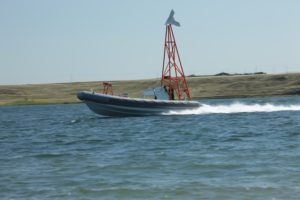
(Photo: QTS)


